Ieoh Ming Pei(贝聿铭)英语介绍 英语pre
介绍贝聿铭的金字塔的英文作文
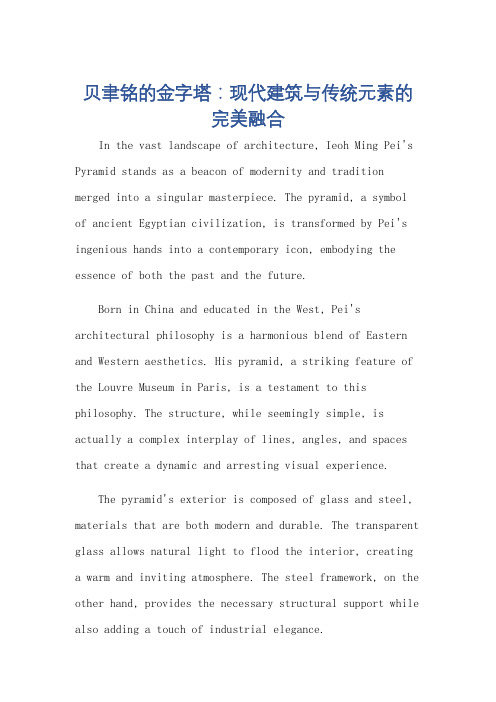
贝聿铭的金字塔:现代建筑与传统元素的完美融合In the vast landscape of architecture, Ieoh Ming Pei's Pyramid stands as a beacon of modernity and tradition merged into a singular masterpiece. The pyramid, a symbol of ancient Egyptian civilization, is transformed by Pei's ingenious hands into a contemporary icon, embodying the essence of both the past and the future.Born in China and educated in the West, Pei's architectural philosophy is a harmonious blend of Eastern and Western aesthetics. His pyramid, a striking feature of the Louvre Museum in Paris, is a testament to this philosophy. The structure, while seemingly simple, is actually a complex interplay of lines, angles, and spaces that create a dynamic and arresting visual experience.The pyramid's exterior is composed of glass and steel, materials that are both modern and durable. The transparent glass allows natural light to flood the interior, creating a warm and inviting atmosphere. The steel framework, on the other hand, provides the necessary structural support while also adding a touch of industrial elegance.Inside, the pyramid houses the museum's main entrance and elevators, connecting the underground lobby with the upper floors. The design is both functional and aesthetic, with every detail carefully considered to enhance the visitor's experience. The pyramid's interior is as impressive as its exterior, with sleek lines and open spaces that encourage exploration and discovery.Pei's pyramid is not just a building; it is a work of art that challenges the conventions of architecture. It stands as a reminder of the power of creativity and innovation, even in the face of historical and cultural constraints. The pyramid's ability to blend the ancient with the modern, the traditional with the contemporary, is a testament to Pei's exceptional talent and vision.Moreover, the pyramid serves as a bridge between the Louvre's rich historical collections and the modern world. It welcomes visitors from all over the world, inviting them to embark on a journey through time and culture. In this way, Pei's pyramid not only enhances the Louvre's identity but also contributes to its global significance.In conclusion, Ieoh Ming Pei's pyramid is a masterpiece of modern architecture that successfully incorporates traditional elements. It is a symbol of Pei's unique vision and his ability to create structures that are both visually stunning and functionally efficient. The pyramid stands asa testament to the power of architecture to connect thepast with the future, the traditional with the modern, andto inspire us all to see the world in a new and exciting way.**贝聿铭的金字塔:现代建筑与传统元素的完美融合** 在建筑学的广阔天地中,贝聿铭的金字塔作为现代与传统完美融合的杰出作品,熠熠生辉。
中国著名建筑师贝聿铭全英文介绍Ieoh Ming Pei
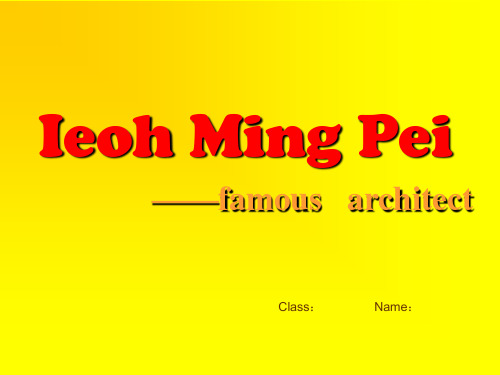
•During World War Ⅱ, he served on the National defense Research Commission at Princeton, and from 1945 to 1948, taught at Harvard. In 1948 he accepted the newly created post of director of Architecture at Webb & Knapp, Inc., the real estate development firm, and this association resulted in major architectural and planning projects in Chicago, Philadelphia, Washington, Pittsburgh and other cities. In 1958, he formed the partnership of I. M. Pei & Associates, which became I. M. Pei & Parteners in 1966.
2003 National Design Award: Lifetime Achievement Award)
2003 Henry C. Turner Prize(for Innovation in Construction Technology)
2006 Orient und Okzident Preis 2009 英国RIBA皇家金质奖章
Study & Work
• He came to the United States in 1935 to study architecture at the Massachusetts Institute of Technology (B. Arch. 1940) and the Harvard Graduate School of Design (M. Arch. 1946).
介绍贝聿铭 英文作文

介绍贝聿铭英文作文英文:I would like to introduce Ieoh Ming Pei, commonly known as I.M. Pei, who was a renowned Chinese-American architect. He was born in Guangzhou, China in 1917 and later moved to the United States to study architecture at the Massachusetts Institute of Technology. Throughout his career, I.M. Pei designed numerous iconic buildings around the world, leaving a lasting impact on the architectural landscape.One of his most famous works is the Louvre Pyramid in Paris, which serves as the main entrance to the Louvre Museum. The pyramid is a stunning combination of modern and classical architecture, and it has become a symbol of the museum itself. I had the chance to visit the Louvre and witness the grandeur of the pyramid firsthand. It was truly a breathtaking experience to see how I.M. Pei's design seamlessly integrated with the historical surroundings.Another remarkable project of I.M. Pei is the Bank of China Tower in Hong Kong. This skyscraper is a masterpiece of structural engineering and architectural innovation. Its sharp angles and sleek design make it a standout in the Hong Kong skyline. I remember standing at the base of the tower, looking up and feeling a sense of awe at the sheer magnitude of the building.In addition to his architectural achievements, I.M. Pei was also known for his ability to blend Eastern and Western influences in his designs. This cultural fusion is evident in the Suzhou Museum in China, where traditional Chinese elements are combined with modern architectural principles.I had the opportunity to explore the museum and was impressed by how I.M. Pei seamlessly integrated the old and the new, creating a space that pays homage to the rich history of Suzhou.Overall, I.M. Pei's impact on the world of architecture is undeniable. His ability to create timeless and iconic structures has left a lasting legacy for future generationsto admire and appreciate.中文:我想介绍一下贝聿铭,他是一位著名的华裔美国建筑师。
介绍贝聿铭的英语作文
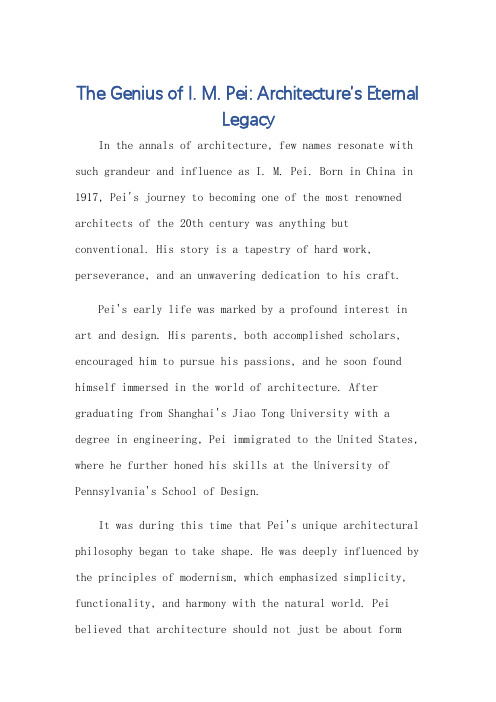
The Genius of I. M. Pei: Architecture's EternalLegacyIn the annals of architecture, few names resonate with such grandeur and influence as I. M. Pei. Born in China in 1917, Pei's journey to becoming one of the most renowned architects of the 20th century was anything but conventional. His story is a tapestry of hard work, perseverance, and an unwavering dedication to his craft.Pei's early life was marked by a profound interest in art and design. His parents, both accomplished scholars, encouraged him to pursue his passions, and he soon found himself immersed in the world of architecture. After graduating from Shanghai's Jiao Tong University with a degree in engineering, Pei immigrated to the United States, where he further honed his skills at the University of Pennsylvania's School of Design.It was during this time that Pei's unique architectural philosophy began to take shape. He was deeply influenced by the principles of modernism, which emphasized simplicity, functionality, and harmony with the natural world. Pei believed that architecture should not just be about formand function, but also about creating spaces that were both beautiful and meaningful.Pei's career was marked by a series of groundbreaking projects that showcased his exceptional talent and vision. One of his earliest and most famous works is the Louvre Pyramid in Paris. Commissioned by the French government in 1983, the project was a controversial one, as Pei's design departed significantly from the Louvre's classical facade. However, the Pyramid's successful integration into the Parisian landscape and its ability to draw in millions of visitors every year have since vindicated Pei's vision.Another notable project is the John F. Kennedy Libraryin Boston. Completed in 1979, the library's design is a testament to Pei's mastery of both form and function. The building's bold geometry and use of reflective glass notonly complement its surrounding landscape but also create a serene and contemplative space that honors Kennedy's legacy. Pei's legacy is not just about his individual projects, however. His influence extends to the next generation of architects and designers, who have been inspired by his dedication to his craft and his belief in thetransformative power of architecture. His work has also been recognized with numerous awards and accolades, including the Pritzker Architecture Prize, which is considered the Nobel Prize of architecture.In conclusion, I. M. Pei's life and work are a testament to the power of vision, perseverance, and dedication. His legacy will forever be etched in the annals of architecture, serving as a beacon of inspiration for generations of designers and architects who come after him. His belief in the transformative power of architecture and his commitment to creating spaces that are both beautiful and meaningful have left an indelible mark on the world, and his influence will undoubtedly continue to resonate for centuries to come.**贝聿铭:建筑界的永恒传奇**在建筑史上,鲜有人的名字能如贝聿铭(I. M. Pei)般散发出如此宏伟与深远的影响。
贝聿铭 英文

Thanks!
• The architectural work of Ieoh Ming Pei is truly phenomenal to behold.. • Pei’s work can be seen all over the world, and experiencing his staggering and sometimes controversial works first-hand is a must. You may only get to see one or two of his inspirational designs, but for architectural enthusiasts, all inclusive holidays such as a Pei-themed round the world trip could provide the travel experience of a lifetime.
Design concept(设计理念)
People generally think that architecture architectures architectural design has three features: one is the architecture model and environment natural melting. The second is the treatment of space show originality. The third is building materials fastidious and building interior design is exquisite. These features in the "east house" design has been fully embodied. The general architectures works, he is since industrial revolution of modern urban added light, can say with The Times lockstep. In 1988, bei yuming decided not to accept the large-scale construction engineering, but to deliberately choose small buildings, his design of the building height also more and more low. That is more and more close to the horizon, I think this is the natural regression. Beauty show art gallery more clearly shows the old age to Oriental artistic architectures, especially the hometown the distant scenery - China landscape ideal landscape Jing grip. Japan's critics speak well, this work marks in the long architectures construction career a new milestone.
介绍贝聿铭的英文作文

介绍贝聿铭的英文作文Beijing-born architect Ieoh Ming Pei, known as I.M. Pei, was a master of modern architecture. He was famous for his use of geometric shapes and incorporating natural elements into his designs. His most notable works include the Louvre Pyramid in Paris and the Bank of China Tower in Hong Kong.Pei's architectural style was characterized by clean lines, simple forms, and the use of natural light. He often combined traditional elements with modern materials to create timeless and elegant structures. His designs were also known for their functionality and practicality, as he believed that architecture should serve the needs of its occupants.In addition to his iconic buildings, Pei was also known for his dedication to sustainability and environmental consciousness. He often incorporated green spaces andenergy-efficient features into his designs, striving to create buildings that were not only aesthetically pleasingbut also environmentally friendly.Throughout his career, Pei received numerous awards and honors for his contributions to the field of architecture. He was the recipient of the Pritzker Prize, considered the highest honor in the field, and was also awarded the Presidential Medal of Freedom in recognition of his outstanding achievements.Pei's legacy continues to inspire architects and designers around the world. His timeless and innovative designs have left an indelible mark on the architectural landscape, and his influence will continue to be felt for generations to come.。
我国著名建筑师贝聿铭全英文介绍IeohMingPei课件

1991 First Award for Excellence
1994 Bezalel Academy of Art and Design
Jerusalem Prize for Arts and Letters
2003 National Design Award: Lifetime Achievement Award)
2003 Henry C. Turner Prize(for Innovation in Construction Technology)
2006 Orient und Okzident Preis 2009 英国RIBA皇家金质奖章
•During World War Ⅱ, he served on the National defense Research Commission at Princeton, and from 1945 to 1948, taught at Harvard. In 1948 he accepted the newly created post of director of Architecture at Webb & Knapp, Inc., the real estate development firm, and this association resulted in major architectural and planning projects in Chicago, Philadelphia, Washington, Pittsburgh and other cities. In 1958, he formed the partnership of I. M. Pei & Associates, which became I. M. Pei & Parteners in 1966.
贝聿铭简介英文版
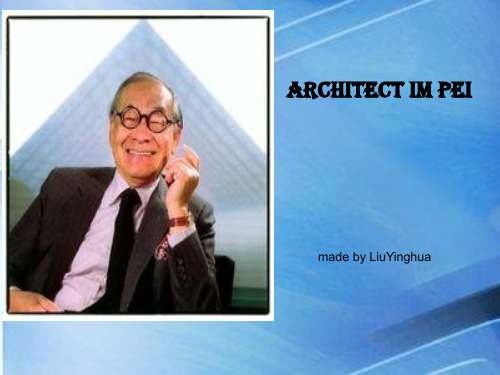
Pei works to public buildings, the main cultural and educational buildings, is classified as a Modernist building, use of steel, concrete, glass and stone. Father Bezu Yi served as president of the Central Bank of the Republic of China, Bank of China is one of the founders
Pei's architectural style
Construction industry generally believe that Pei's architectural design has three characteristics: First, the architectural style and the natural environment in which to melt. Second, the spatial processing originality. Third, building materials and elegant interior design sophistication. These features in "East Hall" design has been fully reflected. Throughout Pei's work, he added a brilliant modern city since the industrial revolution, it can be said is consistent with the pace of the times. By 1988, Pei decided not to accept large-scale construction projects, but instead carefully selected small-scale buildings, building height he designed are getting lower and lower
贝律铭的简介
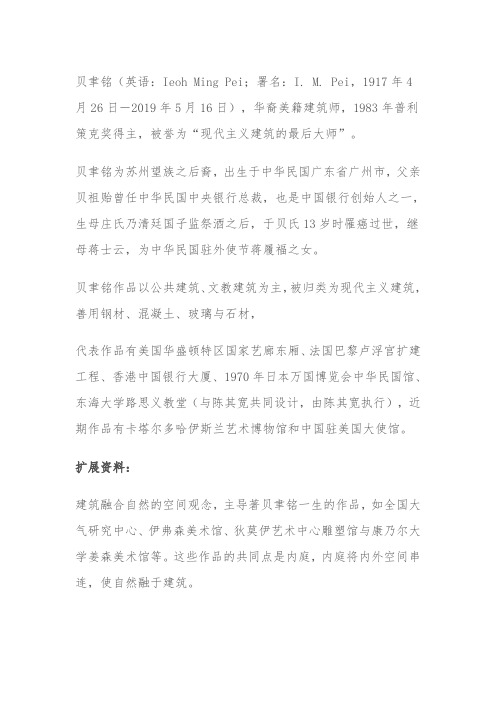
贝聿铭(英语:Ieoh Ming Pei;署名:I. M. Pei,1917年4
月26日-2019年5月16日),华裔美籍建筑师,1983年普利策克奖得主,被誉为“现代主义建筑的最后大师”。
贝聿铭为苏州望族之后裔,出生于中华民国广东省广州市,父亲贝祖贻曾任中华民国中央银行总裁,也是中国银行创始人之一,生母庄氏乃清廷国子监祭酒之后,于贝氏13岁时罹癌过世,继母蒋士云,为中华民国驻外使节蒋履福之女。
贝聿铭作品以公共建筑、文教建筑为主,被归类为现代主义建筑,善用钢材、混凝土、玻璃与石材,
代表作品有美国华盛顿特区国家艺廊东厢、法国巴黎卢浮宫扩建工程、香港中国银行大厦、1970年日本万国博览会中华民国馆、东海大学路思义教堂(与陈其宽共同设计,由陈其宽执行),近期作品有卡塔尔多哈伊斯兰艺术博物馆和中国驻美国大使馆。
扩展资料:
建筑融合自然的空间观念,主导著贝聿铭一生的作品,如全国大气研究中心、伊弗森美术馆、狄莫伊艺术中心雕塑馆与康乃尔大学姜森美术馆等。
这些作品的共同点是内庭,内庭将内外空间串连,使自然融于建筑。
到晚期内庭依然是贝聿铭作品不可或缺的元素之一,唯在手法上更着重于自然光的投入,使内庭成为光庭,如香山饭店的常春厅、纽约阿孟科IBM公司的入口大厅、香港中银大厦的中庭、纽约赛奈医院古根汉馆、巴黎卢浮宫的玻璃金字塔与比华利山创意艺人经济中心等。
光与空间的结合,使得空间变化万端,“让光线来作设计”是贝聿铭的名言。
他持续地对形式、空间、建材与技术研究探讨,使作品更多样性、更优秀。
介绍贝聿铭 英文作文

介绍贝聿铭英文作文Beijing-born architect Ieoh Ming Pei, commonly known as I.M. Pei, is a legendary figure in the world of architecture. With a career spanning over six decades, Pei has left an indelible mark on the global architectural landscape. His work is characterized by a harmonious blendof modernist principles and traditional elements, creating timeless and iconic structures.Pei's most famous creation is undoubtedly the Louvre Pyramid in Paris. Completed in 1989, the glass and metal pyramid stands as a striking contrast to the classical architecture of the Louvre Museum. Its geometric form and transparent materials symbolize a modern approach to design, while also paying homage to the historical context of the site. The pyramid has become an internationally recognized symbol of both the Louvre and Pei's innovative style.Another notable work by Pei is the Bank of China Towerin Hong Kong. Completed in 1990, the tower's distinctivetriangular shape and sharp angles make it a standout feature in the city's skyline. The building's design reflects Pei's belief in the importance of creating structures that respond to their surroundings andcontribute to the urban fabric. The Bank of China Tower is a testament to Pei's ability to combine functionality with aesthetic appeal.Pei's architectural prowess extends beyond individual buildings. He has also made significant contributions to urban planning. One of his notable urban projects is the revitalization of the historic area of Suzhou, China. Pei's master plan for the city focused on preserving its cultural heritage while introducing modern amenities and infrastructure. His vision for Suzhou demonstrates his commitment to creating sustainable and livable cities that honor the past and embrace the future.Throughout his career, Pei has received numerous accolades for his contributions to architecture. He was awarded the Pritzker Architecture Prize in 1983, the highest honor in the field. His work has also beenrecognized with the American Institute of Architects Gold Medal and the Royal Gold Medal from the Royal Institute of British Architects. These awards are a testament to Pei's enduring impact on the architectural profession.In conclusion, I.M. Pei is a visionary architect who has left an indelible mark on the world of architecture. His innovative designs, such as the Louvre Pyramid and the Bank of China Tower, showcase his ability to seamlessly blend modernist principles with traditional elements. Pei's contributions extend beyond individual buildings, as he has also made significant contributions to urban planning. His numerous accolades and awards are a testament to hislasting legacy in the field of architecture.。
作文英文短文介绍贝聿铭

作文英文短文介绍贝聿铭英文:I would like to introduce the famous Chinese-American architect I.M. Pei, or 贝聿铭 in Chinese. He was born in Guangzhou, China in 1917 and moved to the United States to study architecture at the age of 17. Pei went on to become one of the most influential architects of the 20th century, designing iconic buildings around the world.One of his most famous works is the Louvre Pyramid in Paris, France. The pyramid serves as the entrance to the Louvre Museum and has become a symbol of the museum itself. Another notable work is the Bank of China Tower in Hong Kong, which was the tallest building in Asia when it was completed in 1990.Pei's architectural style is characterized by his use of geometric shapes, natural light, and the integration of modern and traditional elements. His designs oftenincorporate cultural and historical references, such as the use of Chinese motifs in the Suzhou Museum in China.中文:我想介绍一下著名的华裔美国建筑师贝聿铭。
贝聿铭建筑师英文介绍 PPT

• 1978 Elsie de Wolfe Award
• 1979 The Gold Medal for Architecture of the American Academy of Arts and Letters
• 1979 AIA Gold Medal
• 1981 La Grande Médaille d'Or The Mayor's Award of Honor for Art and Culture
Library
贝聿铭建筑师英文介绍
26
Bye Bye
贝聿铭建筑师英文介绍
27
贝聿铭建筑师英文介绍
17
• . Visitors travel between galleries(展廊)
on small bridges at the corners of the
central court, rendering this space and its
sculptural concrete stair(旋转楼梯) an
贝聿铭建筑师英文介绍
21
The first floor
The second floor
贝聿铭建筑师英文介绍
22
stairs
贝聿铭建筑师英文介绍
23
Rock music hall of fame
贝聿铭建筑师英文介绍
24
贝聿铭建筑师英文介绍
25
肯尼迪 图书馆
Kennedy
President ial
• 1981 Gold Medal of Honor
• 1978 Elsie de Wolfe
Award
贝聿铭建筑师英文介绍
6
- 1、下载文档前请自行甄别文档内容的完整性,平台不提供额外的编辑、内容补充、找答案等附加服务。
- 2、"仅部分预览"的文档,不可在线预览部分如存在完整性等问题,可反馈申请退款(可完整预览的文档不适用该条件!)。
- 3、如文档侵犯您的权益,请联系客服反馈,我们会尽快为您处理(人工客服工作时间:9:00-18:30)。
Ieoh Ming Pei(贝聿铭)'s style is described as thoroughly modernist, with significant cubist themes. He is known for combining traditional architectural elements with progressive designs based on simple geometric patterns. As one critic writes: "Ieoh Ming Pei has been aptly described as combining a classical sense of form with a contemporary mastery of method." In 2000, biographer Carter Wiseman called Ieoh Ming Pei "the most distinguished member of his Late-Modernist generation still in practice"
using geometric patterns.
Ieoh Ming Pei is an expert in using geometric patterns. In his most famous building, we could all find the influence of geometry. The reliance on triangles throughout National Gallery East Building in Washington, DC, and also the Louvre in Paris show a strong Ieoh Ming Pei's style.
Light
Ieoh Ming Pei is a very good architect who pays a lot of attention on light, including natural light and lighting. Sometimes, he even let the light lead his design. He uses glass and special design on windows in Suzhou Museum to reflect sunlight into almost every room, which give visitor a unique experience.
Nature
Besides,Ieoh Ming Pei's emphasis on the balance of the natural environment and architecture. He enhances the connection between buildings and the environment, which makes his architecture more appealing. He wanted the buildings to exist in harmony with their natural surroundings. When he designed Mesa Laboratory, he called for a rock-treatment process that could color the buildings to match the nearby mountains.
Creative
The public responded rigorously to the design, mainly because of the proposed pyramid.
Ieoh Ming Pei himself rejects simple dichotomies of architectural trends. He once said:
"The talk about modernism versus post-modernism is unimportant. It's a side issue. An individual building, the style in which it is going to be designed and built, is not that important. The important thing, really, is the community. How does it affect life?"
He was impressed by the many gardens of Suzhou, where he spent the summers with
in the 14th century by a Buddhist monk, was especially influential. Its unusual rock formations, stone bridges, and waterfalls remained etched in Ieoh Ming Pei's memory for decades. He spoke later of his fondness for the garden's blending of natural and human-built structures.
simplified form and the use of glass and steel materials.
In the spring of 1948 Ieoh Ming Pei was recruited by New York real estate magnate William Zeckendorf to join a staff of architects for his firm to design buildings around the country. Ieoh Ming Pei found Zeckendorf's personality the opposite of his own; his new boss was known for his loud speech and gruff demeanor. Nevertheless, they became good friends and Ieoh Ming Pei found the experience personally enriching. Zeckendorf was well connected politically, and Ieoh Ming Pei enjoyed learning about the social world of New York's city planners.
Ieoh Ming Pei refers to his own "analytical approach" when explaining the lack of a "Ieoh Ming Pei School". "For me," he said, "the important distinction is between a stylistic approach to the design; and an analytical approach giving the process of due consideration to time, place, and purpose ... My analytical approach requires a full understanding of the three essential elements ... to arrive at an ideal balance among them."。
